Blog Archives
October 19, 2003 
Today the annual Maha Samadhi observances for Gurudeva began with a quiet gathering of all the monks and devotees in the temple.
Our Beloved and Revered Satguru Sivaya Subramuniyaswami
Attained Maha Samadhi on November 12th, 2001
Click to read for Details.
We are pleased to announce the web release of Satguru Sivaya Subramuniyaswami's monumental work on Hindu culture and lifestyle:
Living with Siva.
Click here for the entire text and artwork, now on-line!
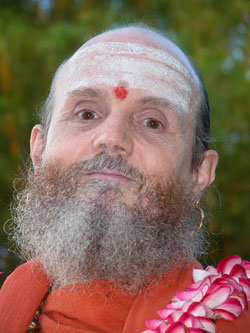
Bodhinatha's talks are being well received world wide. We are having now the interesting experience of hearing people say "Gurudeva was wonderful but Bodhinatha is something else!" which, of course is as it should be... Gurudeva is Bodhinatha and Yogaswami is in Gurudeva and Chellappaswami is in Yogaswami.... Many years ago, Gurudeva aranged a psychic demonstration at the Aadheenam for the younger monks. While the man was in a trance the deva who spoke through him said: "The one you see there sitting on the peedam is the out-picturing of all those who have gone before him."
Bodhinatha's Sun One Video. Most Recent update: September 12, 2003. Bodhinatha speaks on Ahimsa, noninjury, yama #1, which is noninjury in thought, word and deed. The law of karma decrees that it is wise not to harm or hurt others, for we will then receive harm and hurt in exchange in the future. 12 minutes, 29 seconds.
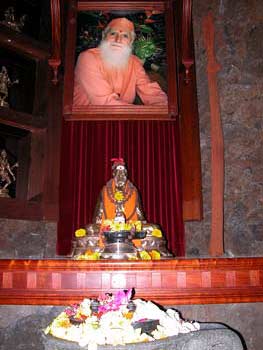
The morning began with a short arati to Gurudeva, then everyone chanted the 108 names of Sivaya Subramuniyaswami. Then the devotees joined the monks in their regular morning routine: meditation following by singing Yogaswami's "Mangalam, Mangalam" Natchintanai song and then Shum chanting.
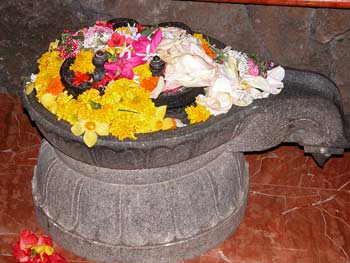
Gurudeva is very much with us on the inner planes... this week is the time for us all to work to develop and strengthen that inner connection with him... He said, "I will be with you 24 hours a day..." and in response to how best to contact him... "You can come talk to me while you are sleeping."
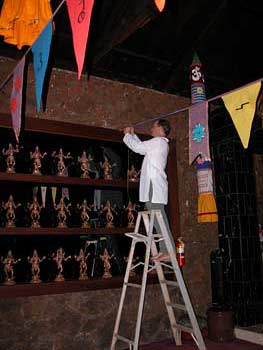
Later in the day devotees come to decorate the temple. Kulapati Deva Seyon hangs Shum banners in the temple.
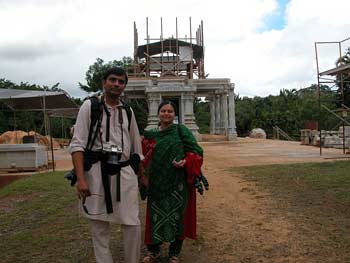
Visitors today taking in a view of Iraivan....
 The Remarkable Vision |
Iraivan Temple Progress Update |
Join this historic undertaking. Please contribute generously. Sponsor a stone today! |
| Order Rudraksha Malas from Siva's sacred Hawaiian groves; and also single rudraksha beads ready to put on a chain around your neck. Great for Gifts! All proceeds go to the building fund. | ||
|
Current Overview  |
||
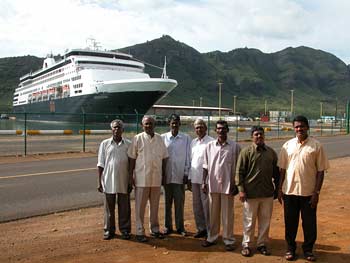
Today we feature the team that is building Iraivan. Yesterday was their monthly outing day and Sadhaka Dandapani and Yogi Japendranatha took them touring.
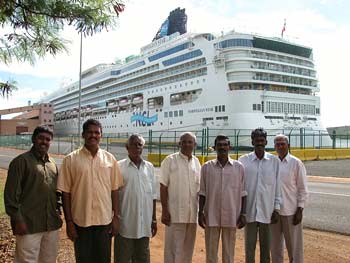
After the usual stop at Wall-Mart to "shop until you drop." they all went to Nawiliwili harbor to take in the sights of the docked cruise liner.

Then off to beautiful Poipu beach on the South side of the island.
In a world where buildings are assembled under huge contracts employing many, many people. who could imagine that Iraivan could go up under the hands of such a small but talented team?
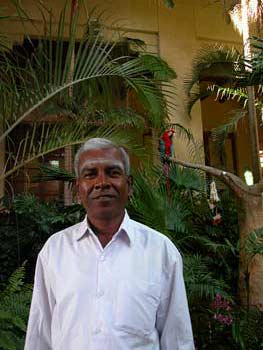
Silpi Sankaran.
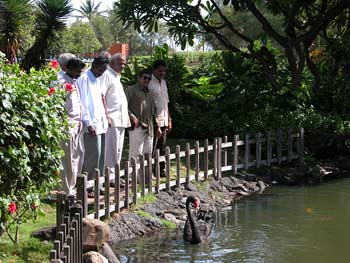
A trip to the posh hotels of Kauai is always to of the silpis list of things they enjoy doing. Here we are at the Hyatt at Poipu.
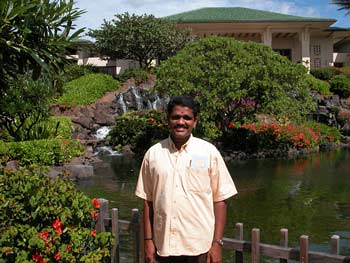
Silpi helper Chinnu. This is Chinnu's second two year tour of service at the Aadheenam. He's a cheerful soul and a great cook!
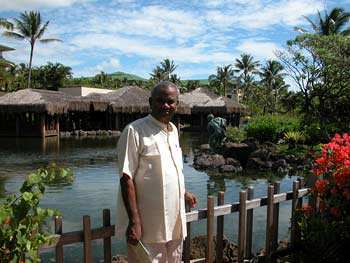
Shanmugam Sthapati, the master mind behind the assembly of the temple. He's getting a name for himself on the island as then the team arrival at the hotel for their walking tour, one of the hotel staff ladies ran up and said: "Oh! you are the chief engineer for the temple..." and she gave everyone brochures and was very helpful.

It would be a rare day for these men to go to a hotel of this caliber in India.
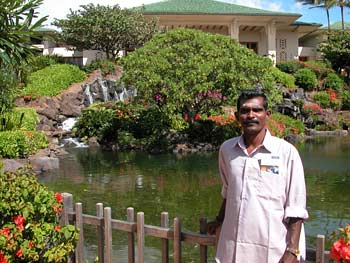
Silpi Karuppaiah
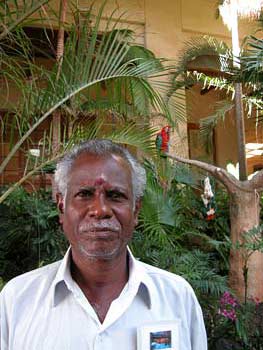
Silpi Sinnakkannu, He's the oldest silpi on the crew and you should see him carve stone! Strength or age is not an issue.. Landing the blow at precisely the right point on the stone to break off just exactly what you want removed. now that is easily said but not easily done... but Sinnakkannu knows how for sure! He also helped Sthapati assemble the giant Tiruvalluvar statue at Kanya Kumari.
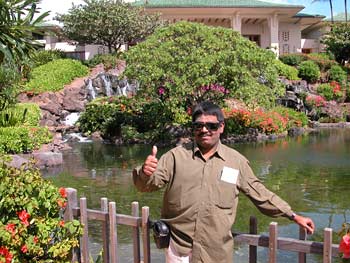
Silpi helper Kumar... He's the only unmarried one among the team and likes to dress in style. He's also a bright young spirit, always in an "up-the-spine feelin' fine" mood, with a very sweet natured religious spirit.
No Audio Today
|
Be surprised! Take this opportunity for an adventure. Close your eyes and click to get a message picked at random from the vast audio archives of our Satgurus' discourses |
And click here for an Index to All Past CyberTalks.
|
| FULL INDEX OF 650+ CYBERTALKS
 |
|
Study Gurudeva's teachings.
|
transcription begins
Date: September_13_2003
Title: The Yama of Ahimsa
Category: Yamas and Niyamas
Duration: 11 min., 23 seconds
Date Given: September 12, 2003
Given by: Bodhinatha
Good Morning, everyone. Wonderful to be back, no place like Kauai! I would tell you about the trip except, you know more about the trip than I do! From reading TAKA and reading all the captions, I think we are almost up to date on the last few days there. It was a nineteen-day trip and every day was packed full of meaningful events. It kept us quite busy.
Coming back to our 'Yamas and Niyamas', we have a redo of the first one. Starting over on the first one, Ahimsa. I found that Gurudeva had very important material in 'Dancing with Siva' on Ahimsa that was not in 'Living with Siva'. So I said, "Whoops, I can't leave that out." It was all about Ahimsa and the law of karma. I thought it was very important to include that, so we redid it with that in mind.
Today's lesson on 'Good Conduct' is on the first Yama of Ahimsa, which is to practice non-injury, not harming others by thought, word or deed, even in your dreams. Live a kindly life, revering all beings as expressions of the One divine energy. Let go of fear and insecurity, the sources of abuse. Knowing that harm caused to others unfailingly returns to oneself, live peacefully with God's creation. Never be a source of dread, pain or injury. Follow a vegetarian diet.
Let us look at some common examples of not following this yama.
First example. An older brother hits the younger brother as a way of acquiring the toy the younger brother is using. Sounds like life, right?
Second example. Husband and wife have a serious disagreement and rather than sit down and talk the problem through, the husband gets angry and solves the problem by hitting his wife.
Third example. A young child is playing in the living room and accidentally tips over a table with a sculpture on it which breaks. The father yells at the child, calling him stupid and worthless.
Fourth example. At work we are working with another employee on a joint project and get frustrated by the employee doing the work slower than we are and speak harshly at him to speed up.
The instinctive tendency that the yama of non-injury harnesses is, of course, the tendency to injure others to acquire what we want. It is also the tendency to respond to challenging situations by becoming upset, angry and finally harming others with our words or our fists.
Here is a story to further illustrate ahimsa.
Gurudeva often told the story of Swami Sivananda being attacked by a man who hit him forcefully in the head with an axe during the evening Satsang at his Rishikesh ashram. Swamiji's outraged followers soon subdued the man. The next day Swami Sivananda met with his attacker, giving him a train ticket home, several spiritual books and money. Swamiji said, "Thank you so much for being the instrument to bring this karma back to me. Now I am free of it." He felt no anger toward the man whatsoever.
The law of karma provides us with our first insights into the philosophical basis of Ahimsa, that whatever harm you cause another will unfailingly come back to you.
Tirukural, Chapter 32 is entitled 'Avoidance of Injuring Others' and insightfully states this perspective in verse 319: If a man visits sorrow on another in the morning, sorrow will visit him unbidden in the afternoon.
It is quite clear that if we initiate harmful actions, we will be harmed in the future. But what about retaliation? Isn't that justified? The other person has harmed me first, surely I am justified in harming him back?
A deeper reflection on the law of karma will show us that it was our karma to be harmed in the first place. The other person was just the instrument for it. We can't blame him for what happened, we can only blame ourselves. We caused this to happen to us by our past actions.
If we retaliate, it starts an endless cycle of being harmed and harming others which is only stopped by our finally considering the consequences before acting and not harming back.
Mahatma Gandhi once said, "An eye for an eye makes the whole world blind." So too, instinctive retaliation ultimately makes the whole world angry.
Tirukural verse 141 states this perspective of non-retaliation: It is the principle of the pure in heart never to injure others even when they themselves have been hatefully injured.
However, the fact that we do not retaliate does not mean the offender should not face the consequences of his or her actions. It simply means we channel those consequences through a person authorized to handle the matter and give out a proper discipline or punishment.
For example, for children at school they would tell the matter to a teacher. For problems with the neighbors, children would tell the matter to their parents. For an adult at work, we tell the matter to a supervisor. If the person has broken the law, we can tell the matter to the police.
Even when we control ourselves and don't retaliate, it is easy to still be upset with the offender and inwardly hold a grudge against him for doing what he did. Of course, the goal is to totally forgive him for what he did to you and move on without any grudge.
Tirukural, Chapter 32 has a verse on this perspective as well: If you return kindness for injuries received and forget both, those who harmed you will be punished by their own shame.
But what about evil people? Isn't it acceptable to harm them?
From the Hindu perspective, all people are intrinsically good. Even those who act in misguided adharmic ways are intrinsically good. What we can guard against is taking on the Western perspective that some people are intrinsically evil, the enemy and therefore it is alright to treat them in a different way than those who are intrinsically good. They are simply young souls and need to be disciplined by the justice system for the misdeeds, but certainly not harmed.
Again the Kural in verse 313 addresses this issue as well: Harming others, even enemies who harmed you unprovoked, surely brings incessant sorrow.
So far we have looked at Ahimsa from the point of view of the law of karma. A deeper philosophical perspective for the principle of Ahimsa is the view point of the divinity within all. When we see the divine in someone, we naturally do not want to hurt them.
Gurudeva gives us a simple but quite effective way of seeing the divine in another person, which is to look deeply into the eyes of the other person. Look beyond the individual's personality, go deeper than his or her intellect and see the pure life energy as God.
The great saying or Mahavakya that describes this approach to experiencing the divine is, "God is the Life of our life."
This practice does not just stop with people but should also include trying to see the life energy in trees, birds and animals. This is because God is our life. God is the life in all people. God is the life in the trees and the birds and in the animals. Becoming aware of this life energy in all that lives, is becoming aware of God's loving presence within us.
Tirukural, Chapter 33, 'Avoidance of Killing', takes the idea of not harming any living creature one step further in enjoining us to protect all living creatures. "Of all the virtues summed by ancient sages, the foremost are to share one's food and to protect all living creatures."
The philosophical perspective of the divine within all life deepens even further when we strongly believe in the existence of God everywhere, as an all-pervasive, self-effulgent energy and consciousness.
The classic story of Semmanaselvi nicely illustrates the oneness of all. Semmanaselvi is an old lady who hired a laborer to do her part in building the dam to keep the river from flooding her village. Of course, the laborer was God Siva in disguise. The laborer shirks his duties and the King hits him with a cane. The laborer disappears and everyone feels the hit.
The message of this story is usually stated as God Siva is within everyone and therefore what happens to Him is felt by all. However, we can also state the message of the story as, at the core of our soul we are all one and what happens to one person, happens to all. Said another way, if we hurt another we are also hurting ourself.
In conclusion: Practice non-injury, not harming others by thought, word or deed even in your dreams. Live a kindly life, revering all beings as expressions of the One divine energy. Let go of fear and insecurity, the sources of abuse. Knowing that harm caused to others unfailingly returns to oneself, live peacefully with God's creation. Never be a source of dread, pain or injury. Follow a vegetarian diet.
Aum Namah Sivaya.
transcription ends
|
MORE UPLIFTING THINGS |
2004 Indian Odyssey
Join Satguru Bodhinatha Veylanswami on an 18 day Innersearch to South India, from Jan 19 to Feb 5, as we pilgrimage to ancient monasteries, magnificent 1,000 plus year old sacred temples and meet with India's holy men in a life-transforming adventure. Click on the above link for more details. |
|

|
Check our children and youth section for new items for the young and young at heart! | |
|
1. SIGN OUR GUESTBOOK and receive a FREE GIFT |
||
| 2. Newest Book: LIVING WITH SIVA | ||
|
3. Visiting KAUAI'S HINDU MONASTERY |
||
|
4. Contribute to THANK YOU, GURUDEVA FUND |
||